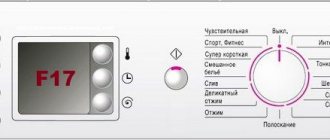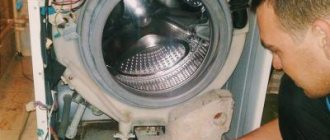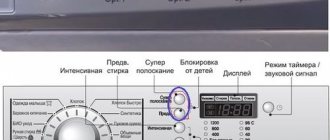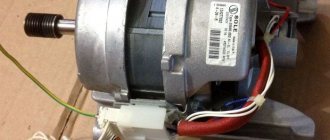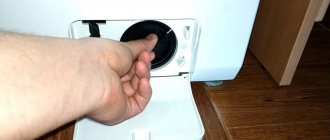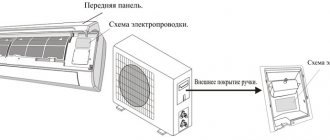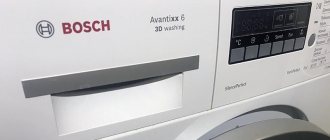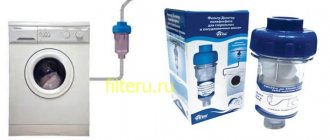Household appliances of this type have long become an indispensable attribute for most households. Purchasing and connecting washing machines to sewerage and water supply has long become commonplace and most of us know how it’s done.
However, in this article we will dwell on the issue in detail and analyze all the nuances of connecting to water supply and sewerage, what methods exist, what tools and materials we will need, and how to avoid common mistakes.
But first, let's briefly learn how to connect a washing machine: the hose for connecting cold water is screwed at one end to the water pipe, and the other to the filler fitting of the machine. The end of the drain hose at a certain height is connected to the sewer system. Below, we will look at all the processes in more detail.
Materials and tools for connecting to water supply and sewerage
The need for certain materials when installing and connecting washing machines to sewerage and water supply is determined, first of all, by the location of the unit and the accessibility of the designated objects. In some cases, it is necessary to incur significantly higher costs in order to subsequently use household appliances conveniently for many years.
If you plan to lay additional branches from the water supply in the groove, you will need a fairly powerful angle grinder with a saw blade for concrete. You can use a hammer and a chisel to break out the concrete.
A pipe without joints is laid in the groove to ensure its long-term operation without leakage. Otherwise, if a leak occurs, restoring the functionality of the pipe will involve a large amount of troubleshooting work.
To connect to the water supply network, a tee with a shut-off valve is usually used, and to install it in place, a set of wrenches or a universal adjustable wrench is used. All threaded connections are sealed with tow or FUM tape.
Installing an external pipe involves attaching the pipe to the wall; for this you will need an electric drill and concrete drills. Plastic dowels are installed in the drilled holes, fastening is carried out with screws of the appropriate size.
When installing washing machines, the main requirement is that the top cover is horizontal in relation to the floor. For precise installation of the washing machine, a building level is used; adjustment is made using screw support legs.
To arrange a drain for washing machines into the sewer, you will need a drain adapter with an outlet at an angle of 45 degrees.
To connect washing machines to electricity, you will need a three-core cable with a cross-section of 2.5 square meters in double insulation and a 16-amp diffusion machine with a leakage current of no more than 30 milliamps.
In addition, it is possible to use control equipment - a voltmeter. Let’s take a closer look at how to properly connect the washing machine to the mains below.
Pros and cons of a mounted unit
A mini wall-mounted washing machine has several significant advantages over its floor-standing counterparts:
The disadvantages include a small drum volume and not the highest quality of washing. Such models are really not suitable for a large family, and they wash and spin sometimes worse than floor-standing machines of class A. But small-format equipment is indispensable if you need to quickly put things in order after a working day.
Installation and connection may be difficult. It is difficult to install a mini-machine yourself, even despite its low weight and the presence of manufacturer’s instructions. There are few specialists with experience in such work, because the model appeared recently and is not particularly popular. This automatically leads to an increase in the cost of the service.
The compact electric assistant is ideal for a bachelor's apartment. Single people who keep their house in order rarely accumulate mountains of laundry. They usually prefer to wash things as they get dirty. The drum volume is sufficient for a set of casual clothes or bed linen.
The hanging model is indispensable for families with small children, where mothers have to wash soiled things after every walk. However, you can hardly rely solely on the mounted baby. It is advisable to also have a voluminous standard model for washing bedspreads, bed linen, and blankets.
Preparing washing household appliances for installation
First of all, when the unit is delivered to the installation site, it needs to be unpacked. Usually the machine is packed in a cardboard box and secured with plastic tape. It needs to be cut and removed.
After this, the cardboard box is carefully removed and the foam pads are removed from the top and sides. Next, you need to lift the car and pull out the lower foam platform.
In this case, it is worth paying attention to its design - if there is no special boss in the middle on which the device drum rests in the transport position, then in this design it is manufactured and installed separately. You need to tilt it and remove this insert.
Please note that the cardboard packaging and foam pads must be retained for the duration of the warranty. If a situation arises in which you need to replace the machine due to its defect, this operation will not take place without packaging. These are the terms of the guarantee.
Inside the cardboard package there is an envelope or folder with technical documentation. It contains:
- A passport for the purchased washing machine indicating the personal unit number and other credentials. All entries in it must be certified by the store’s seal.
- A warranty card, which is certified by the store’s seal indicating the date of sale, since the countdown of the warranty period begins with it.
- Operating instructions, starting from the moment of unpacking, and instructions on the installation procedure.
You should strictly follow all the manufacturer's requirements, since failure to comply with any of them will result in a waiver of warranty obligations.
Connecting a washing machine
The packaging also contains the components of the purchased washing machine. Typically they include:
- Flexible filling hose equipped with plastic union nuts for connection to the machine and water supply;
- drain hose for removing used water after washing and spinning clothes;
- reduction – an intermediate part for connecting the drain hose to the sewer pipe;
- bracket for fixing the drain hose on the wall;
- wrench for removing transportation screws and adjusting the position of household appliances in space before turning them on;
- plugs installed on the holes for transportation screws after they are removed.
These are the main items of the sales kit, which may differ from model to model.
If your washing machine breaks down, you can connect the motor from it to a 220 V network with your own hands.
Removing shipping screws
This is a mandatory operation before connecting washing machines to water supply and sewerage.
Their purpose is to secure the drum during transportation to prevent damage. As noted above, a tool for removing bolts is included in the sales package.
Under no circumstances should the removed screws be thrown away; they will be useful if you need to transport the washing machine to a warranty workshop. The holes where the transport screws were must be closed with the covers included in the sales kit.
Placement options for washing household appliances
Household appliances of this kind are not purchased spontaneously; the purchase is preceded by careful analysis and preparation. First of all, this applies to the installation location.
The need to drain used water determines the location of washing machines as close as possible to the distribution of the sewer system.
Such points are located either in the bathroom or in the kitchen. There is also a water supply network there.
As for connecting to electricity, washing machines may require a separate power supply line from the input panel to the location where the outlet is installed.
Typical device and operating features
The devices of wall-mounted washing machines on the market are similar to each other. The pioneer in this market niche was the DWD-CV701 model; it went on sale in 2012 and has already confidently won an army of fans. Those who managed to purchase a compact device note some shortcomings, but are generally satisfied.
The first washing machine is made in the form of a shiny parallelepiped with rounded corners - in the best futuristic traditions. The drum is loaded from the front, and the door is made of transparent plastic, through which silver parts are visible. It looks like a porthole.
Light shiny surfaces optically expand the space, and even a small bathroom seems larger and cleaner. The design of the model is ideal for rooms decorated in modern, high-tech, and minimalist styles.
Ease of use is an important factor. If the machine is installed on the wall, taking into account the owner’s height, it is much easier to load laundry into it than into a floor-standing model. In addition, the weight of things does not exceed 3 kg, which makes the task easier.
The compartments for washing powder and conditioner in Daewoo units are shaped like spoons, making them very convenient for dosing bulk and liquid products.
The manufacturing company took care of the safety of customers and thought through a child protection system. It is turned on by pressing the “Program” plus “Rinse” and “Spin” buttons and holding them for 5 seconds.
The functionality includes several programs. As a rule, there is a wash in cold water, a cycle for children's and delicate items, cycles for cotton at +40°C and +60°C.
You can run the device without washing - only in rinse and spin mode (700-800 rpm). After washing, things remain damp, but water does not drain from them. Some mini-washers have a hygienic drum cleaning option.
Bonuses for picky buyers are the silent operation of the inverter motor, almost complete absence of vibration and the honeycomb coating of the drum, which protects delicate fabrics. We also recommend that you familiarize yourself with the rating of full-size inverter washing machines.
Over time, Daewoo has diversified the range of wall-mounted units, the quality of washing has improved, the design has changed slightly, and options for delaying start and hygienic cleaning of the drum have been added. The features of different models, their functionality and user reviews are displayed in the rating of wall-mounted washing machines.
Connecting washing machines to the water supply - several connection methods
Watch the video - the first method of establishing a connection to the water supply
How to install a washing machine, connecting the washing machine to the water supply. Video tutorial Plumber
The sales package for such a unit always includes a hose for connecting cold water. Its length is 1.2-1.5 meters and at the ends the hose is equipped with two union nuts made of plastic.
One of the ends is installed on the hose at a right angle. It must be installed on the inlet of the unit. The installation angle prevents the hose from kinking or pinching. Connection is made in the following order:
- Turn off the water supply to the water supply by turning off the tap on the riser.
- Unscrew the flexible cold water line at the sink or sink.
- Install the tee onto the supply pipe in the water supply system so that the side outlet is located conveniently for connecting the washing machine hose.
- Screw the filling hose to the tee. When tightening the plastic nut, do not use a tool, and only tighten the nut until it stops by hand. Tool installation often results in breakage of the flimsy plastic nut.
- Install the flexible mixer hose.
A test supply of water to the system with the washing machine should be carried out with the tap on the crosspiece closed, and only after making sure that there are no leaks can it be opened to check the reliability of the hose connection.
This connection option is used when the installation location of the unit coincides with the location of the sink or sink.
Otherwise, you need to bring the water closer to it. To do this, a tee is inserted into the nearest water pipe.
An additional pipe of the water supply system is extended to the installation site of the washing machine, where it is connected in the manner described above.
Often, filling the household with household appliances occurs gradually; eventually, under the sink or sink, the entire space is filled with tees and a tangle of various hoses.
How to connect a washing machine (review video)
Providing for this possibility, a manifold with several outlets is installed on the embedded pipe. An output that is not currently in use can be closed with a plug and used at the right time.
What kind of breakdowns happen?
Hanging laundry devices, like their bulkier floor-standing counterparts, sometimes break. Possible malfunctions:
Before purchasing such a device, you should evaluate the loading requirements - how many dirty things accumulate per day, how often you have to wash it. For one person, the mounted version can become a full-fledged washing machine, but for a family, it will rather be a convenient addition to a more spacious assistant, capable of washing 6–9 kg of laundry per cycle.
Source
Connecting washing machines to the sewer - consider 2 methods
Watch the video - the first method of installing a drain into the sewer
Washing machine. Drain through non-return valve. Eliminating the siphon effect
Draining used water into the sewer system is a mandatory process in the operation of units of this kind, because the purification of contaminated wastewater is becoming increasingly important.
If we simply talk about organizing the drainage of water from washing machines into the sewer system, we can do without directly connecting these two systems.
It is enough to use a U-shaped bracket from the unit sales kit, which fixes the drain pipe on the edge of the bathtub. At the same time, the issue of the height of the drain into the sewer is resolved, due to which a water plug is formed, preventing the reverse flow of water.
Many modern units include the installation of a check valve that prevents this process.
Considering the specific location of the sewer system in a house or apartment, there are no problems with connection, but it has its own specifics.
Connecting to the sewer directly is used quite often, being the simplest to implement. But this method has its drawbacks.
To implement this, it is necessary to install a spacer to the sewer pipe in the form of a tee, and the outlet should be at an angle of 45 degrees.
The drainage hose is connected to a sewer pipe with a diameter of 50 millimeters, while its size is 22 mm. Therefore, the connection is made using a special spacer called a “reduction”.
The drainage hose of washing machines is standardized on all models and has a diameter of 22 millimeters. There are no special adapters for draining this size; this simple rubber part is used on the transition.
When the machine is located in close proximity to the outlet of a sewer pipe, it is naturally connected to it using a tee.
Do-it-yourself connections of the washing machine to water and sewerage
But if the unit is located at the opposite end of the room, the most reasonable solution would be to lay an additional PVC pipe with a diameter of 32 millimeters and then switch to size 50.
In this case, it is necessary to fulfill the requirements for a slope of this pipe of 2-3 millimeters per meter of length. A reduction with these dimensions is produced and can be purchased on the market.
In some cases, if the machine is automatic, there is no need to use an intermediate pipe, since the used water is pumped out by a pump.
In this case, the connection is made using a rubber reduction. It is a rubber bushing. The outer surface has ribs like a cuff to seal the connection. The inner hole is arranged in the same way with a diameter of the appropriate size.
In the technical documentation, if there is no check valve in the machine model being installed, the height of the drain from the floor at which a water seal is formed must be indicated.
If this parameter is not maintained, very unpleasant odors will penetrate into the room through the drain hole.
The second way to connect washing machines to the drain is to connect through a siphon. Many of these products are available with a special outlet at the top.
When sold, it is equipped with a special plug that covers the pipe. Before connecting the drain hose of the machine, this part must be removed and removed - it has purely protective functions.
The drain hose of the washing machine is simply put on this pipe and, if necessary, additionally secured with a clamp.
This product can be equipped with several taps, which allows the connection of several units at the same time.
If there is such a possibility, connecting washing machines should be done in such a way that is quite reliable and solves all problems of tightness and safety.
Video
We bring to your attention a video with a detailed overview of the characteristics of the DAEWOO DWD-CV701PC mini wall-mounted machine.
She graduated from the Institute of Tourism of the Federal Pedagogical University with a degree in Management, loves to travel and communicate with people. She is interested in psychology, enjoys dancing, and studies English. During the five years of maternity leave, I thoroughly mastered housekeeping, not forgetting about my own development. He skillfully uses words and can support a conversation on any topic thanks to his interest in different areas of life.
Found a mistake? Select it and click the buttons:
Washing machines equipped with the “No Iron” or “Easy Iron” functions can wash clothes with little to no wrinkling. This effect is achieved through a special approach to spinning - it is performed at low speeds, with long pauses, and a small amount of water is retained in the tank.
There are a variety of balls that are used in the washing machine. Antistatic ones will prevent the fabric from sticking to the body after washing, balls with special loops will “comb” the lint and prevent the appearance of pills, and silicone ones with pimples will prevent fluff from matting when washing outerwear.
The first officially patented washing machine was made of wood and was a box with a frame, half filled with wooden balls. Laundry for washing and detergent were loaded inside and the frame was moved using a lever, which, in turn, made the balls move and grind the laundry.
The expression “soap opera” (“soap”) did not arise by chance. The very first series and shows that had a female audience were broadcast on television at a time when housewives did cleaning, ironing and laundry. In addition, to attract female viewers to the screens, commercials for detergents: soaps and powders were often played on air.
Washing machines have something to do with the origin of the expression “money laundering.” In the 1930s, American gangsters used a network of laundries as a cover for their illegal activities. By passing off the proceeds of crime as proceeds from cleaning clothes, they turned “dirty” money into “clean” money.
History knows the fact that a kitten fell into the drum of a washing machine and, after going through a full wash cycle on the “Wool” program, got out of the unit unharmed. The only trouble for the pet was an allergy to washing powder.
There is a washing machine “for bachelors”. Linen washed in such a unit does not need to be ironed at all! The thing is that the device does not have a drum: some things can be placed inside the container directly on hangers (for example, jackets and shirts), and smaller things (for example, underwear and socks) can be placed on special shelves.
Connecting washing machines to the electrical network
When making repairs in a bathroom or kitchen, you must provide wiring for connecting a washing machine or other similar equipment. It should be understood that combining water and electricity in one unit makes it a means of increased danger. Therefore, separate wires are pulled to connect them.
Connecting the washing machine drain to the sewer system, what problems and errors occur
Based on the maximum total power possible in such household appliances, you should usually focus on 2.3-3.0 kW.
What you need to connect
The list of materials for creating an autonomous network for connecting household appliances is not extensive and includes:
- Conductor products are selected from copper samples. At the same time, taking into account the place of application, they must be double insulated.
- An emergency shutdown control device that will save household appliances from failure due to voltage surges, and the building from a possible fire. The equipment will not be damaged if moisture gets into the electrical network.
How to connect a washing machine to a Miele three-phase network
To connect washing machines, a 16-amp device with a leakage current of no more than 30 milliamps is used.
- An automatic switch with the same parameters is installed in case of a short circuit and protects the network from damage.
- High security socket with moisture protection.
- Additional materials include common parts for electrical installation - clamps, terminals, junction boxes, cable ducts, etc.
Electrical installation
We draw your attention to the need to follow all the rules in order to ensure your own safety and the safety of your property and home:
- During installation, you must use only professionally designed connection diagrams.
- Do not twist aluminum and copper wires together.
- To carry out wiring, you need to use wires only of the appropriate cross-sectional power.
- Grounding cannot be done by connecting a wire to a water pipe or hot water supply.
- The sockets used must be made on a ceramic base in a waterproof casing.
- It is strictly not recommended to use an extension cord or adapter from a regular outlet to a Euro plug to connect washing machines.
- It is prohibited to connect the ground wire to the neutral wire.
- The connection wire must be laid as a separate line.
After completing the electrical installation, it is recommended to carefully check the entire circuit with a tester to eliminate the possibility of a short circuit.
Connecting the washing machine to water supply, sewerage and electricity.
Conclusions and useful video on the topic
Review of the wall-mounted machine from Daewoo, its design, functionality and specifics of operation:
Step-by-step master class on installing a wall-mounted washing machine:
This unique little thing can be installed not only at home or in the country. A yacht is a very suitable place, according to one buyer:
Compact wall-mounted washing machines have found their consumer - the demand for such models is gradually increasing. Manufacturers are just beginning to develop this category of household appliances, but it is already clear that in the near future we can expect the appearance of new models from other brands.
Do you have personal experience using a wall-mounted washing machine? Please share it with our readers and tell us about the features of the innovative device. Write your comments and ask questions in the block below.
Source
How to level a washing machine
This operation is final and is performed after it is connected to all communications. If this is not done, the machine will be overloaded during operation, and strong drum vibrations will occur, which will not extend its service life.
The top cover of the unit must be positioned horizontally. To do this you need to perform the following operations:
- Install the washing machine in its permanent location. The distance from the back panel to the wall should be no more than 5 centimeters, otherwise the hoses may be deformed or broken.
- Loosen the locknuts on the machine legs.
- Use a spirit level to determine the direction of rise or fall.
- Adjust the position of the unit by unscrewing or tightening the screws. The tolerance for non-parallelism of the cover in relation to the floor is no more than 2 degrees.
- Having achieved the correct position of the machine body, you need to tighten the locknuts to the body.
- It is important to prevent vibration of the unit, which can occur if there is a gap between the leg and the floor. To do this, you need to try to swing the body in different directions. If necessary, tighten the legs until the same tightening force is achieved.
Alignment
It is very important that the unit stands level relative to the floor surface, otherwise overloads will occur and the machine may quickly fail. To prevent it from “jumping” due to the imbalance of the drum, it is also important to set the technique correctly.
The machine should not swing under any circumstances; all four legs should be firmly installed on the surface. You can determine whether the washing machine is tilted relative to the floor by looking at the level by simply placing it on top of the unit.
To adjust the position of the equipment, do not use foreign objects, for example, wooden blocks or pieces of linoleum. The height of the unit is changed by twisting the legs.
The position of the washing machine relative to the floor is adjusted by changing the height of the legs
First start
To check the functionality of the installed washing machine, it is necessary to carry out a test wash. This is done in the following order:
- Connect the machine to the network.
- Select the desired washing mode and set it on the display.
- Enable work mode. When pouring water into the tank, monitor its filling time in comparison with the passport data. If the machine fills slowly, it is necessary to check the pressure in the water supply and, if necessary, take measures to increase it in accordance with the passport recommendations.
- Check the water heating time for the selected mode.
- When filling the tank with water, check for leaks; if there are any, eliminate the cause and repeat the tests.
The program and rules for conducting a trial run are described in detail in the relevant technical documentation. Recommendations for different models may differ, but these should be used as a guide.
Model overview
On the domestic market, the suspended type SMA is represented by the Korean brand Daewoo. Let's consider several models - budget versions, new items, models with drying.
Daewoo Electronics DWD-CV701 PC
The most inexpensive modification among mounted SMAs from Daewoo. It has electronic controls and a digital display - everything as it should be in a modern SMA. White body. Electricity consumption - 0.18 kWh/kg. Partial protection against leaks (housing). There is protection against children. Control of foaming and imbalance. There is a super rinse and many useful programs. Specifications:
| Maximum load, kg | 3 |
| Spin speed, rpm | 700 |
| type of instalation | wall-mounted |
| Load Type | frontal |
| Tank material | plastic |
| Energy class | A |
| Washing class | IN |
| Spin efficiency class | WITH |
| Water consumption, l | 36 |
| Number of programs | 6 |
| Dimensions (WxDxH), cm | 55x29x60 |
| Weight, kg | 17 |
| Cost, rubles | 15 800 |
| Drying | No |
The owners who took the risk of buying a small hanging device, at a price comparable to bulky washing machines serving large families, did not regret it. They noted the following advantages of the DWD-CV701 PC:
Not without its drawbacks:
Users noted that breakdowns do happen. Problems with the electrical part, water leaks, and depressurization of pipes were mentioned. A good machine for 1 person. Or it can complement a full-fledged washing machine.
Korean developers don't stop there. The omissions and imperfections of this model were taken into account in subsequent developments. The brand has already brought to market more advanced versions for wall mounting.
Daewoo Electronics DWD-CV703W - new
A new modification in the model range of wall-mounted SMAs from Daewoo. Touch control and digital display. White body. There is protection against children. There is no protection against leaks. There is tank cleaning. A star type drum is installed. Delayed start - up to 18 hours. Technical characteristics:
| Maximum load, kg | 3 |
| Spin speed, rpm | 700 |
| type of instalation | wall-mounted |
| Load Type | frontal |
| Tank material | plastic |
| Energy class | A |
| Washing class | A |
| Spin efficiency class | E |
| Water consumption, l | 31 |
| Number of programs | 6 |
| Dimensions (WxDxH), cm | 55x32x60 |
| Weight, kg | 17,3 |
| Cost, rubles | 29 000 |
| Drying | No |
Inferior in energy efficiency to full-size washing machines. Today, the best versions have classes A+, A++, A+++. But given the miniature size of the device, the consumer will not incur large costs on power consumption. Although this is a new product, reviews have already appeared on the Internet. Consumers who did not regret paying almost 30,000 rubles for the opportunity to quickly and economically wash a couple of things speak positively about the new product. They mark it:
Daewoo Electronics DWC-CV703S
Another new product from the Korean brand. The developers were pleased - this modification includes drying. True, only 1.5 kg, but compared to the load, this is a lot. There is only one drying program. Because of this addition, the modification is slightly more expensive than the previous version. The energy efficiency class is lower for the same reason. The body color is silver. Hatch color is black. There is no protection against leaks. Cleaning and refreshing the tank. The drum is star-shaped. Technical specifications:
| Maximum load, kg | 3 |
| Spin speed, rpm | 700 |
| type of instalation | wall-mounted |
| Load Type | frontal |
| Tank material | plastic |
| Energy class | D |
| Washing class | A |
| Spin efficiency class | E |
| Water consumption, l | 25 |
| Number of programs | 8 |
| Dimensions (WxDxH), cm | 55x32x60 |
| Weight, kg | 19,8 |
| Cost, rubles | 30 700 |
| Drying | No |
There are no reviews yet for this new product, equipped with a dryer. But given the popularity of its predecessors, reviews and comments will undoubtedly appear soon. You can find out about all the new products in the household appliances market on Yandex.Market. Here you can read reviews about the technology you are interested in.
